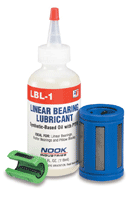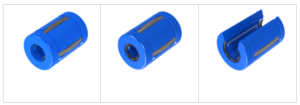In order to get the best performance and life out of your linear bearings, proper lubrication is key.
A lubricant formulated for rolling friction should be used with linear bearings. In applications where operating speeds are low and loads are light, linear bearings can be used without lubrication at a greatly reduced life. However, it is never recommended to operate linear bearings without lubrication. To protect the highly polished bearing surfaces from corrosion and wear, a lubricant is required.
Where linear speeds are high, a light oil should be used and provision for re-lubrication should be made to avoid operating the bearings dry. For typical applications, a medium-to- heavy oil has good surface adhesion and affords greater bearing protection. Linear bearings 2 inches in diameter and above may use high pressure lithium grease such as Shell Alvania #2 for moderate speed applications. Lubricants containing additives such as molydisulfide or graphite should not be used.


